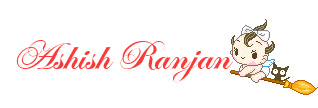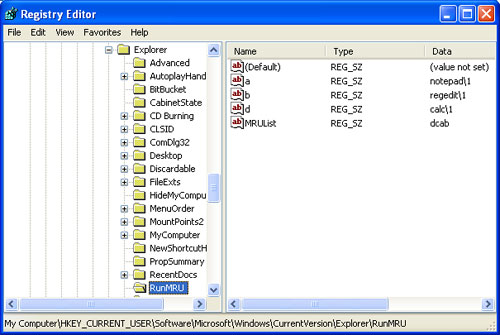List of All 174 Run Commands for Windows
Steps For “How to Run these Commands”.
Go to Start Menu – Run and type in the command to run the specific application. Command are in front of the Program, while program names are first in the list. So, It comes in handy if you have the list of all programs with you.
Run command increases you productivity and saves lot of time as you don’t require to access start menu to launch any application or system utility.
Run Commands Listed below In Alphabetical order :-
Steps For “How to Run these Commands”.
Go to Start Menu – Run and type in the command to run the specific application. Command are in front of the Program, while program names are first in the list. So, It comes in handy if you have the list of all programs with you.
Run command increases you productivity and saves lot of time as you don’t require to access start menu to launch any application or system utility.
Run Commands Listed below In Alphabetical order :-
| Program | Run Command |
| Accessibility Controls | access.cpl |
| Accessibility Wizard | accwiz |
| Add Hardware Wizard | hdwwiz.cpl |
| Add/Remove Programs | appwiz.cpl |
| Administrative Tools | control admintools |
| Adobe Acrobat ( if installed ) | acrobat |
| Adobe Distiller ( if installed ) | acrodist |
| Adobe ImageReady ( if installed ) | imageready |
| Adobe Photoshop ( if installed ) | photoshop |
| Automatic Updates | wuaucpl.cpl |
| Basic Media Player | mplay32 |
| Bluetooth Transfer Wizard | fsquirt |
| Calculator | calc |
| Ccleaner ( if installed ) | ccleaner |
| C: Drive | c: |
| Certificate Manager | cdrtmgr.msc |
| Character Map | charmap |
| Check Disk Utility | chkdsk |
| Clipboard Viewer | clipbrd |
| Command Prompt | cmd |
| Command Prompt | command |
| Component Services | dcomcnfg |
| Computer Management | compmgmt.msc |
| Compare Files | comp |
| Control Panel | control |
| Create a shared folder Wizard | shrpubw |
| Date and Time Properties | timedate.cpl |
| DDE Shares | ddeshare |
| Device Manager | devmgmt.msc |
| Direct X Control Panel ( if installed ) | directx.cpl |
| Direct X Troubleshooter | dxdiag |
| Disk Cleanup Utility | cleanmgr |
| Disk Defragment | dfrg.msc |
| Disk Partition Manager | diskmgmt.msc |
| Display Properties | control desktop |
| Display Properties | desk.cpl |
| Display Properties (w/Appearance Tab Preselected ) | control color |
| Dr. Watson System Troubleshooting Utility | drwtsn32 |
| Driver Verifier Utility | verifier |
| Ethereal ( if installed ) | ethereal |
| Event Viewer | eventvwr.msc |
| Files and Settings Transfer Tool | migwiz |
| File Signature Verification Tool | sigverif |
| Findfast | findfast.cpl |
| Firefox | firefox |
| Folders Properties | control folders |
| Fonts | fonts |
| Fonts Folder | fonts |
| Free Cell Card Game | freecell |
| Game Controllers | joy.cpl |
| Group Policy Editor ( xp pro ) | gpedit.msc |
| Hearts Card Game | mshearts |
| Help and Support | helpctr |
| Hyperterminal | hypertrm |
| Hotline Client | hotlineclient |
| Iexpress Wizard | iexpress |
| Indexing Service | ciadv.msc |
| Internet Connection Wizard | icwonn1 |
| Internet Properties | inetcpl.cpl |
| Internet Setup Wizard | inetwiz |
| IP Configuration (Display Connection Configuration) | ipconfig /all |
| IP Configuration (Display DNS Cache Contents) | ipconfig /displaydns |
| IP Configuration (Delete DNS Cache Contents) | ipconfig /flushdns |
| IP Configuration (Release All Connections) | ipconfig /release |
| IP Configuration (Renew All Connections) | ipconfig /renew |
| IP Configuration (Refreshes DHCP & Re-Registers DNS) | ipconfig /registerdns |
| IP Configuration (Display DHCP Class ID) | ipconfig /showclassid |
| IP Configuration (Modifies DHCP Class ID) | ipconfig /setclassid |
| Java Control Panel ( if installed ) | jpicpl32.cpl |
| Java Control Panel ( if installed ) | javaws |
| Keyboard Properties | control keyboard |
| Local Security Settings | secpol.msc |
| Local Users and Groups | lusrmgr.msc |
| Logs You Out of Windows | logoff |
| Malicious Software Removal Tool | mrt |
| Microsoft Access ( if installed ) | access.cpl |
| Microsoft Chat | winchat |
| Microsoft Excel ( if installed ) | excel |
| Microsoft Diskpart | diskpart |
| Microsoft Frontpage ( if installed ) | frontpg |
| Microsoft Movie Maker | moviemk |
| Microsoft Management Console | mmc |
| Microsoft Narrator | narrator |
| Microsoft Paint | mspaint |
| Microsoft Powerpoint | powerpnt |
| Microsoft Word ( if installed ) | winword |
| Microsoft Syncronization Tool | mobsync |
| Minesweeper Game | winmine |
| Mouse Properties | control mouse |
| Mouse Properties | main.cpl |
| MS-Dos Editor | edit |
| MS-Dos FTP | ftp |
| Nero ( if installed ) | nero |
| Netmeeting | conf |
| Network Connections | control netconnections |
| Network Connections | ncpa.cpl |
| Network Setup Wizard | netsetup.cpl |
| Notepad | notepad |
| Nview Desktop Manager ( if installed ) | nvtuicpl.cpl |
| Object Packager | packager |
| ODBC Data Source Administrator | odbccp32 |
| ODBC Data Source Administrator | odbccp32.cpl |
| On Screen Keyboard | osk |
| Opens AC3 Filter ( if installed ) | ac3filter.cpl |
| Outlook Express | msimn |
| Paint | pbrush |
| Password Properties | password.cpl |
| Performance Monitor | perfmon.msc |
| Performance Monitor | perfmon |
| Phone and Modem Options | telephon.cpl |
| Phone Dialer | dialer |
| Pinball Game | pinball |
| Power Configuration | powercfg.cpl |
| Printers and Faxes | control printers |
| Printers Folder | printers |
| Private Characters Editor | eudcedit |
| Quicktime ( if installed ) | quicktime.cpl |
| Quicktime Player ( if installed ) | quicktimeplayer |
| Real Player ( if installed ) | realplay |
| Regional Settings | intl.cpl |
| Registry Editor | regedit |
| Registry Editor | regedit32 |
| Remote Access Phonebook | rasphone |
| Remote Desktop | mstsc |
| Removable Storage | ntmsmgr.msc |
| Removable Storage Operator Requests | ntmsoprq.msc |
| Resultant Set of Policy ( xp pro ) | rsop.msc |
| Scanners and Cameras | sticpl.cpl |
| Scheduled Tasks | control schedtasks |
| Security Center | wscui.cpl |
| Services | services.msc |
| Shared Folders | fsmgmt.msc |
| Sharing Session | rtcshare |
| Shuts Down Windows | shutdown |
| Sounds Recorder | sndrec32 |
| Sounds and Audio | mmsys.cpl |
| Spider Solitare Card Game | spider |
| SQL Client Configuration | clicongf |
| System Configuration Editor | sysedit |
| System Configuration Utility | msconfig |
| System File Checker Utility ( Scan Immediately ) | sfc /scannow |
| System File Checker Utility ( Scan Once At Next Boot ) | sfc /scanonce |
| System File Checker Utility ( Scan On Every Boot ) | sfc /scanboot |
| System File Checker Utility ( Return to Default Settings) | sfc /revert |
| System File Checker Utility ( Purge File Cache ) | sfc /purgecache |
| System File Checker Utility ( Set Cache Size to Size x ) | sfc /cachesize=x |
| System Information | msinfo32 |
| System Properties | sysdm.cpl |
| Task Manager | taskmgr |
| TCP Tester | tcptest |
| Telnet Client | telnet |
| Tweak UI ( if installed ) | tweakui |
| User Account Management | nusrmgr.cpl |
| Utility Manager | utilman |
| Volume Serial Number for C: | label |
| Volume Control | sndvol32 |
| Windows Address Book | wab |
| Windows Address Book Import Utility | wabmig |
| Windows Backup Utility ( if installed ) | ntbackup |
| Windows Explorer | explorer |
| Windows Firewall | firewall.cpl |
| Windows Installer Details | msiexec |
| Windows Magnifier | magnify |
| Windows Management Infrastructure | wmimgmt.msc |
| Windows Media Player | wmplayer |
| Windows Messenger | msnsgs |
| Windows Picture Import Wizard (Need camera connected) | wiaacmgr |
| Windows System Security Tool | syskey |
| Windows Script host settings | wscript |
| Widnows Update Launches | wupdmgr |
| Windows Version ( shows your windows version ) | winver |
| Windows XP Tour Wizard | tourstart |
| Wordpad | write |
| Zoom Utility | igfxzoom |





















